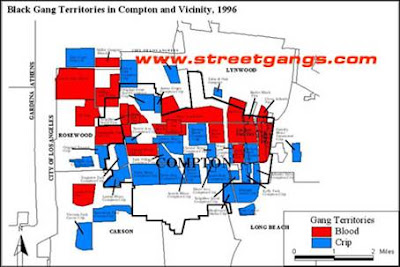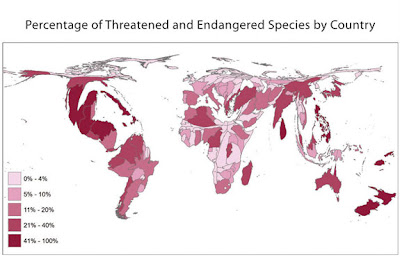 - Nominal Choropleth maps portray areal data that area broken down by a group or category.
- Nominal Choropleth maps portray areal data that area broken down by a group or category.- This map is being used to represent the location and size of two gangs in Compton California.
- www.streetgangs.com
 - Nominal Choropleth maps portray areal data that area broken down by a group or category.
- Nominal Choropleth maps portray areal data that area broken down by a group or category. - A bivariate map displays two variables on a single map by combining two different sets of graphic symbols or colors. It is a variation of simple choropleth map that portrays two separate phenomena simultaneously.
- A bivariate map displays two variables on a single map by combining two different sets of graphic symbols or colors. It is a variation of simple choropleth map that portrays two separate phenomena simultaneously.


 - A proportional circle map shows the relative sizes of objects or events. The larger the circle on the map, the greater the magnitude of the measured object by the scale.
- A proportional circle map shows the relative sizes of objects or events. The larger the circle on the map, the greater the magnitude of the measured object by the scale.
- A Digital Orthophoto Quadrangle (DOQ) is a computer-generated image of an aerial photograph in which the image displacement caused by terrain relief and camera tilt has been removed. The DOQ combines the image characteristics of the original photograph with the georeferenced qualities of a map.
- The map above is a DOQQ of the Washington DC area. These types of maps seem very easy to see details.
- http://seamless.usgs.gov/website/seamless/products/1doqq.asp

 - A Digital Line Graph (DLG) is digital vector data representing cartographic information. DLGs contain a wide variety of information depicting geographic features.
- A Digital Line Graph (DLG) is digital vector data representing cartographic information. DLGs contain a wide variety of information depicting geographic features. - A DRG map is the original hard copy only, but now available in digital format as a DRG (digital raster graphic), a scanned and georectified image of the paper version).
- A DRG map is the original hard copy only, but now available in digital format as a DRG (digital raster graphic), a scanned and georectified image of the paper version).
 - Isohyets maps show predicted rainfall in various measurements.
- Isohyets maps show predicted rainfall in various measurements. - Isotach maps are used to calculate wind speeds. Lines that encompass areas, are of equal wind speed.
- Isotach maps are used to calculate wind speeds. Lines that encompass areas, are of equal wind speed. 
 - LIDAR (Light Detection Ranging) optical remote sensing technology that measures properties of scattered light to find range and/or other information of a distant target. The prevalent method to determine distance to an object or surface is to use laser pulses.
- LIDAR (Light Detection Ranging) optical remote sensing technology that measures properties of scattered light to find range and/or other information of a distant target. The prevalent method to determine distance to an object or surface is to use laser pulses. - Doppler Radar is composed of two components, reflectivity and rotational velocity. When the two of them come together, they can help see hurricanes, tornadoes, and storm patterns.
- Doppler Radar is composed of two components, reflectivity and rotational velocity. When the two of them come together, they can help see hurricanes, tornadoes, and storm patterns. - Black and white aerial photos are in some cases just the same as infrared. Their purpose is to
- Black and white aerial photos are in some cases just the same as infrared. Their purpose is to 
- Infrared Aerial photos are to create false color imagery helps delineate surface features. Which in this map you can clearly see it does just this.
- This is the Tarpon Bay Keys, Florida, as depicted on topographic sheet and then in a 1999 false color infra-red aerial photograph. The two images are not to equal scales. I really liked this display, because you can actually see the differences with the infrared.
- http://sofia.usgs.gov/publications/ofr/2006-1126/vegetation.html
 - The objective of cartographic animation is to visualize a phenomenon that would not be apparent if the maps were viewed individually.
- The objective of cartographic animation is to visualize a phenomenon that would not be apparent if the maps were viewed individually. - Cartograms are maps where the geographic unit being looked at has it size and shape altered to reflect the magnitude of the variable being looked at.
- Cartograms are maps where the geographic unit being looked at has it size and shape altered to reflect the magnitude of the variable being looked at. - Flow maps show the movement of objects from one location to another, such migration, traffic, goods, or use in technology. The advantage of flow maps is that they reduce visual clutter by merging edges and having clean lines.
- Flow maps show the movement of objects from one location to another, such migration, traffic, goods, or use in technology. The advantage of flow maps is that they reduce visual clutter by merging edges and having clean lines. - A line connecting points of equal value, especially on a map. The "iso" means equal, so where the lines are connecting they are equal.
- A line connecting points of equal value, especially on a map. The "iso" means equal, so where the lines are connecting they are equal.

 - A dot distrobution map is to portray quantitative data as a dot which represents a number of the phenomenon found within the boundary of a geographic area. The pattern of distributed dots reflects the general locations where the phenomenon was most likely to occur.
- A dot distrobution map is to portray quantitative data as a dot which represents a number of the phenomenon found within the boundary of a geographic area. The pattern of distributed dots reflects the general locations where the phenomenon was most likely to occur.
 - A Hypsometric map gives elevations by contouring, or sometimes by means of shading, tinting, or batching.
- A Hypsometric map gives elevations by contouring, or sometimes by means of shading, tinting, or batching.